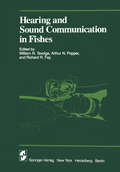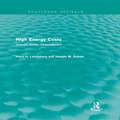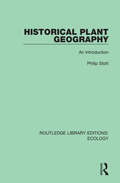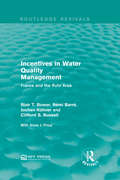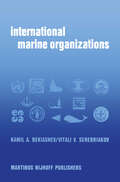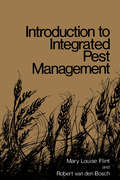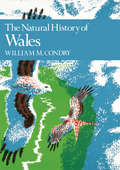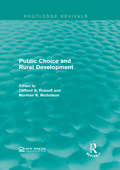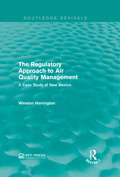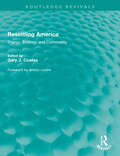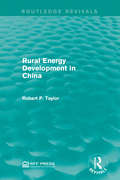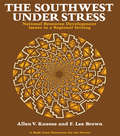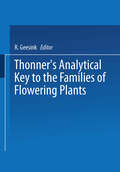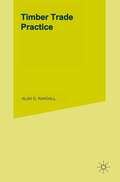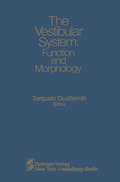- Table View
- List View
Hearing and Sound Communication in Fishes (Proceedings in Life Sciences)
by W. N. Tavolga A. N. Popper R. R. FayThis volume is a compilation of the papers presented at a meeting that took place in April 1980 at the Mote Marine Laboratory, Sarasota, Florida. The meeting and this volume are outgrowths of two earlier international meetings on marine bio-acoustics that occurred in 1963 and 1966 (Tavolga 1964, 1967). The first meeting took place at the Lerner Marine Laboratory of the American Museum of Natural History, while the second meeting was at the American Museum itself, and was under the sponsorship of the Department of Animal Behavior. It is apparent that these two volumes have had immense impact on the current study of marine bio-acoustics, and particularly on fish audition. In a preliminary conference in Sarasota in 1979 we decided that it was time for another such meeting, to bring together as many as possible of the investigators interested in fish acoustics in order to assess the current state of our knowledge and predict directions for research for the next several years. Such a meeting appeared par ticularly timely, since over the past four or five years there have been many new studies that have provided new empirical and theoretical work on basic mechanisms of fish audition. Furthermore, it became evident, as we made up preliminary lists of possible participants, that few of the currently active workers were in the field back in 1966. In fact, of the current participants, only Drs.
High Energy Costs: Uneven, Unfair, Unavoidable? (Routledge Revivals)
by Hans H. Landsberg Joseph M. DukertHigh energy prices affect nearly the whole of the American population, arguably affecting some consumer groups more than others. Although originally published in 1981, the issues explored in this study such as who is affected most by energy price increases, regional differences and what can or should be done in the United States in regards to energy costs are still as relevant today as they were then. These papers attempt to directly address these concerns in the wake of the 1979-80 price shock in America and to advise what action can be taken to allay these concerns. This title will be of interest to students of environmental studies and economics.
High Energy Costs: Uneven, Unfair, Unavoidable? (Routledge Revivals)
by Hans H. Landsberg Joseph M. DukertHigh energy prices affect nearly the whole of the American population, arguably affecting some consumer groups more than others. Although originally published in 1981, the issues explored in this study such as who is affected most by energy price increases, regional differences and what can or should be done in the United States in regards to energy costs are still as relevant today as they were then. These papers attempt to directly address these concerns in the wake of the 1979-80 price shock in America and to advise what action can be taken to allay these concerns. This title will be of interest to students of environmental studies and economics.
Historical Plant Geography: An Introduction (Routledge Library Editions: Ecology #12)
by Philip StottOriginally published in 1981 Historical Plant Geography is an introductory treatment of historical plant geography and stresses the basic theoretical frame of the subject. The book is about neither the study of vegetation nor the concept of the ecosystem, instead focusing on the much older tradition concerned with analysing the geographical distribution of individual species and natural plant groups. Important areas are discussed, such as global plate tectonics and sea-floor spreading, plant maps are introduced and there is a basic treatment of recent advances in plant taxonomy. The book will appeal to students and academics of geography, botany, ecology and environmental sciences.
Historical Plant Geography: An Introduction (Routledge Library Editions: Ecology #12)
by Philip StottOriginally published in 1981 Historical Plant Geography is an introductory treatment of historical plant geography and stresses the basic theoretical frame of the subject. The book is about neither the study of vegetation nor the concept of the ecosystem, instead focusing on the much older tradition concerned with analysing the geographical distribution of individual species and natural plant groups. Important areas are discussed, such as global plate tectonics and sea-floor spreading, plant maps are introduced and there is a basic treatment of recent advances in plant taxonomy. The book will appeal to students and academics of geography, botany, ecology and environmental sciences.
Incentives in Water Quality Management: France and the Ruhr Area (Routledge Revivals)
by Blair T. Bower Rémi Barré Jochen Kühner Clifford S. RussellIncentives in Water Quality Management explores the role of effluent charges in France and the Ruhr area of the federal republic of Germany by delving into both regulatory and economic systems that are utilised in the water quality management of these two areas. Originally published in 1981, these studies place an emphasis on the necessity of legislation in effective water quality management whilst attempting to create a complete picture of the water quality management systems in place in France and the Ruhr area. This title will be of interest to students of Environmental Studies.
Incentives in Water Quality Management: France and the Ruhr Area (Routledge Revivals)
by Blair T. Bower Rémi Barré Jochen Kühner Clifford S. RussellIncentives in Water Quality Management explores the role of effluent charges in France and the Ruhr area of the federal republic of Germany by delving into both regulatory and economic systems that are utilised in the water quality management of these two areas. Originally published in 1981, these studies place an emphasis on the necessity of legislation in effective water quality management whilst attempting to create a complete picture of the water quality management systems in place in France and the Ruhr area. This title will be of interest to students of Environmental Studies.
The Indoor Climbing Manual: Improvisation And The Theatre (Bloomsbury Revelations Ser.)
by John WhiteClimbing indoors has undergone a revolution.Indoor walls are no longer seen as simply a means to help climbers develop skills and get a bit fitter for 'the real thing'. These days many climbers prefer them, opting for the security of bolt-protected, weatherproof climbs. And why not? Excellent climbing facilities have sprung up everywhere, from primary schools and universities to massive, purpose-built centres offering hundreds of climbs and dedicated training facilities. And some climbers are buying the holds from specialised companies and setting up walls at home.The Indoor Climbing Manual is an authoritative and comprehensive guide, steering the reader through the variety of styles, skills and techniques needed to master the climbing wall, and includes:· An introduction to the equipment required· Top rope climbing, lead climbing and bouldering techniques· Advanced techniques and training to improve your climbing· Guidelines on how to climb safely and prevent injury· Tips for the transition from indoor to outdoor climbing· An overview of competitive climbing
International Marine Organizations: Essays on Structure and Activities
by K.A. Bekiashev V.V. SerebriakovIn the last few years, the quantity of books and papers on the political, economic and legal problems of the exploration and use of the sea and marine resources has considerably increased. But the status and activities of intern a tional organizations related to maritime shipping, fisheries, scientific research in the World Ocean and the protection of the marine environment have not yet, as a whole, been represented in the scientific and reference literature. It would be fair, though, to mention that some general information on marine international organizations may be found in the Yearbook of International Organizations, Brussels, 1979; in Annotated Acronyms and Abbreviations of Marine Science Related International Organizations, U. S. Department of Commerce, 1976; and in the UN Annotated Directory ofIntergovernmental Organizations Concerned with Ocean Affairs, 1976. Voluminous informa tion on organizations engaged in problems of the exploration and use ofthe sea is given in International Marine Organizations by the well-known Polish scientists Lopuski and Symonides, 1978. Meanwhile the increasing volume of practical work related to the participa tion of governmental and scientific bodies as well as individual scientists and specialists in these organizations, the necessity of long-term planning in this field, and the perspectives of the development of these organizations, make necessary a special publication depicting the structure and many-sided activi ties of such international bodies. This book is the first one in which the most complete information on the main marine international organizations is presented.
Introduction to Integrated Pest Management
by M.L. Flint R. van den BoschIntegrated control of pests was practiced early in this century, well before anyone thought to call it "integrated control" or, still later, "integrated pest management" (IPM), which is the subject of this book by Mary Louise Flint and the late Robert van den Bosch. USDA entomologists W. D. Hunter and B. R. Coad recommended the same principles in 1923, for example, for the control of boll weevil on cotton in the United States. In that program, selected pest-tolerant varieties of cotton and residue destruction were the primary means of control, with insecticides consid ered supplementary and to be used only when a measured incidence of weevil damage occurred. Likewise, plant pathologists had also developed disease management programs incorporating varietal selection and cul tural procedures, along with minimal use of the early fungicides, such as Bordeaux mixture. These and other methods were practiced well before modern chemical control technology had developed. Use of chemical pesticides expanded greatly in this century, at first slowly and then, following the launching of DDT as a broadly successful insecticide, with rapidly increasing momentum. In 1979, the President's Council on Environmental Quality reported that production of synthetic organic pesticides had increased from less than half a million pounds in 1951 to about 1.4 billion pounds-or about 3000 times as much-in 1977.
The Natural History of Wales (Collins New Naturalist Library #66)
by William. M. CondryThis book is an attempt to survey the natural history of the whole of Wales. It therefore covers such areas as Snowdonia and the Brecon Beacons as well as the spectacularly beautiful Pembrokeshire coast and the less well-known but no less interesting areas of mid-Wales.
Poems of Thomas Hardy: A New Selection (Macmillan Collector's Library #90)
by Thomas HardyThomas Hardy saw himself, first and foremost, as a poet, and he wrote poetry throughout his prolific and acclaimed novel-writing years before announcing in 1896 that he would no longer write novels, much to the astonishment of his worldwide readership. Instead he went on to publish eight masterful volumes of poetry - ranging from lyrics and ballads to dramatic monologues and satire - and is now regarded as one of the greatest twentieth-century poets.Choosing the best verse from each volume, the Poems of Thomas Hardy is the perfect introduction to Hardy's lyrical, soul-searching and profoundly sincere poetry, covering subjects ranging from his grief at the death of his first wife to his experiences of war.This beautiful Macmillan Collector's Library edition is edited and introduced by editor Ned Halley.Designed to appeal to the booklover, the Macmillan Collector's Library is a series of beautiful gift editions of much loved classic titles. Macmillan Collector's Library are books to love and treasure.
Public Choice and Rural Development (Routledge Revivals)
by Clifford S. Russell Norman K. NicholsonThis title, originally published in 1981, explores the difficult, and at times volatile, relationship between public choice and rural development in developing countries. The book is organised into three major sections: the first section examines important general themes, the second describes how public choice and rural development intertwine in some areas of concern to aid donors, and finally, the third section revisits the major themes discussed in the book and offers further understanding to the critical questions and problems at hand. It is a valuable resource for students interested in environmental studies and development studies.
Public Choice and Rural Development (Routledge Revivals)
by Clifford S. Russell Norman K. NicholsonThis title, originally published in 1981, explores the difficult, and at times volatile, relationship between public choice and rural development in developing countries. The book is organised into three major sections: the first section examines important general themes, the second describes how public choice and rural development intertwine in some areas of concern to aid donors, and finally, the third section revisits the major themes discussed in the book and offers further understanding to the critical questions and problems at hand. It is a valuable resource for students interested in environmental studies and development studies.
The Regulatory Approach to Air Quality Management: A Case Study of New Mexico (Routledge Revivals)
by Winston HarringtonIn the wake of the Clean Air Amendments of 1970 in the United States, sources of emissions could be held accountable for the degradation of air quality in the local environment. This case study of air quality management in New Mexico was produced to shed some light on the procedures and activities used by agencies in order to control air quality. Originally published in 1981, Winston Harrington uses New Mexico as a case study for its largely centralised control system in Santa Fe to explore the behaviour of air quality agencies and pollution sources and comments on policy implications from this study’s conclusions. This title will be of interest to students of environmental studies and policy makers.
The Regulatory Approach to Air Quality Management: A Case Study of New Mexico (Routledge Revivals)
by Winston HarringtonIn the wake of the Clean Air Amendments of 1970 in the United States, sources of emissions could be held accountable for the degradation of air quality in the local environment. This case study of air quality management in New Mexico was produced to shed some light on the procedures and activities used by agencies in order to control air quality. Originally published in 1981, Winston Harrington uses New Mexico as a case study for its largely centralised control system in Santa Fe to explore the behaviour of air quality agencies and pollution sources and comments on policy implications from this study’s conclusions. This title will be of interest to students of environmental studies and policy makers.
Resettling America: Energy, Ecology and Community (Routledge Revivals)
Every movement has its bellweathers, the ideas that lead the way and rally its adherents towards a set of shared values and visions. Resettling America was one such beacon – a publication for its time and ahead of its time. Those of us doing the work of sustainability and the transformation of communities feel grateful for Gary’s early and prescient contribution that has shaped the thinking of so many around the US and beyond. Essential reading for all green warriors! Jason F. McLennan, Chief Sustainability Officer – Perkins & Will. Founder, Living Building Challenge. Originally published in 1981 and now reissued with a new Preface by Gary J. Coates, Resettling America was one of the first comprehensive, transdisciplinary books on the crisis of sustainability and the implications of that crisis for the re-design of buildings, towns, cities and regions. Through essays by Coates, which provide a theory of ecological design, and case studies written by leading authors and activists of the time, the book presents a strategic vision of how it would be possible to create a sustainable and livable society through a process of cooperative community development rooted in a radical re-visioning of nature, self and society. By providing a strategic vision, as well offering practical means for creating a sustainable society worth sustaining, Resettling America remains more relevant and inspiring than ever to those who face the ecology of crises that now surround us in the 21st Century.
Resettling America: Energy, Ecology and Community (Routledge Revivals)
by Gary J. CoatesEvery movement has its bellweathers, the ideas that lead the way and rally its adherents towards a set of shared values and visions. Resettling America was one such beacon – a publication for its time and ahead of its time. Those of us doing the work of sustainability and the transformation of communities feel grateful for Gary’s early and prescient contribution that has shaped the thinking of so many around the US and beyond. Essential reading for all green warriors! Jason F. McLennan, Chief Sustainability Officer – Perkins & Will. Founder, Living Building Challenge. Originally published in 1981 and now reissued with a new Preface by Gary J. Coates, Resettling America was one of the first comprehensive, transdisciplinary books on the crisis of sustainability and the implications of that crisis for the re-design of buildings, towns, cities and regions. Through essays by Coates, which provide a theory of ecological design, and case studies written by leading authors and activists of the time, the book presents a strategic vision of how it would be possible to create a sustainable and livable society through a process of cooperative community development rooted in a radical re-visioning of nature, self and society. By providing a strategic vision, as well offering practical means for creating a sustainable society worth sustaining, Resettling America remains more relevant and inspiring than ever to those who face the ecology of crises that now surround us in the 21st Century.
Rural Energy Development in China (Routledge Revivals)
by Robert P. TaylorIn this title, originally published in 1981, author Robert P. Taylor calls for a greater understanding of rural energy supply and consumption patterns in the developing countries. Here, Taylor specifically examines the rural energy development in China as it is the world’s largest developing country in terms of population, and it has encountered many of the rural energy problems common in other developing countries. This study provides an analysis of China’s rural energy economy from before 1949 to a general discussion of achievements in rural energy development and the rural energy economy in 1981. This is an ideal title for students interested in environmental studies and development studies.
Rural Energy Development in China (Routledge Revivals)
by Robert P. TaylorIn this title, originally published in 1981, author Robert P. Taylor calls for a greater understanding of rural energy supply and consumption patterns in the developing countries. Here, Taylor specifically examines the rural energy development in China as it is the world’s largest developing country in terms of population, and it has encountered many of the rural energy problems common in other developing countries. This study provides an analysis of China’s rural energy economy from before 1949 to a general discussion of achievements in rural energy development and the rural energy economy in 1981. This is an ideal title for students interested in environmental studies and development studies.
The Southwest Under Stress: National Resource Development Issues in a Regional Setting
by Allen V. Kneese F. Lee BrownSouthwest Under Stress examines the development-environment conflict in the four contiguous states of Arizona, Utah, Colorado, and New Mexico. It emphasizes three issues with implications that extend far beyond the Southwest: water---its quantity, quality, and allocation; environment---how and to what extent it should be preserved; and the future of Native American and other poverty-stricken peoples. Energy comes in for special attention because the Southwest is a principal repository of fossil and nuclear fuels. This book serves as a guide for public policy in the region, and many of the policy alternatives set out are aimed at state and local governments. Alleviating poverty, improving the lot of Native Americans, and formulating workable water, environmental, and natural resources development policies are all of special concern to the region, but the federal government has asserted a dominant role in may of these areas. The book discusses ways in which the federal role may change to improve both federal policy itself and cooperation with other levels of government.
The Southwest Under Stress: National Resource Development Issues in a Regional Setting
by Allen V. Kneese F. Lee BrownSouthwest Under Stress examines the development-environment conflict in the four contiguous states of Arizona, Utah, Colorado, and New Mexico. It emphasizes three issues with implications that extend far beyond the Southwest: water---its quantity, quality, and allocation; environment---how and to what extent it should be preserved; and the future of Native American and other poverty-stricken peoples. Energy comes in for special attention because the Southwest is a principal repository of fossil and nuclear fuels. This book serves as a guide for public policy in the region, and many of the policy alternatives set out are aimed at state and local governments. Alleviating poverty, improving the lot of Native Americans, and formulating workable water, environmental, and natural resources development policies are all of special concern to the region, but the federal government has asserted a dominant role in may of these areas. The book discusses ways in which the federal role may change to improve both federal policy itself and cooperation with other levels of government.
Thonner’s analytical key to the families of flowering plants (Leiden Botanical Series #5)
by R. GeesinkThe Vestibular System: Function and Morphology
by T. GualtierottiVestibular physiology has acquired new interest in the past few years. The development of fast aircraft, beginning during the Second World War and continuing through modern supersonic jets and space travel, has increased dramatically the acceleration range to which man is subjected, from prolonged weightlessness to several gs. The labyrinth measures all kinds of acceleration, including gravity. and therefore has taken on particular impor tance in the study of human health in the Space Age. It is understandable. then, that NASA sponsored the Symposium on Vestibular Function and Morphology. a satellite of the Eighth Annual Meeting of the Society of Neuroscience. held October 30-November 1. 1978, at the University of Pittsburgh, which also supported the symposium. The present volume was developed from papers originally presented there. My strategy in editing this book has been to focus upon the vestibular end organ and its direct connections. both peripheral and central, in order to as sure a coherent discussion of the basics of vestibular function, structure, and ultrastructure. Fortunately, it was possible to secure the contributions of a number of outstanding investigators from both the United States and abroad, including functionally oriented morphologists. ultrastructuralists, biophysicists, and vestibular physiologists. The result is a comprehensive discussion of the main mechanisms of the labyrinth: the transduction pro cess at the receptor level, in the semicircular canals, and in the utricular and saccular maculae; the information transfer through neuronal pathways to the nuclei and the cerebellum; and the general organization of the system.
